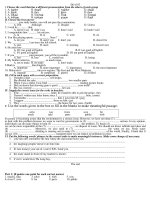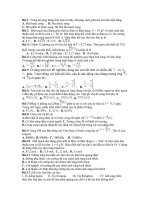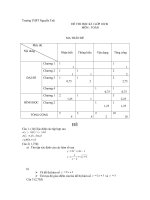DE THI THU TNQG 3
Bạn đang xem bản rút gọn của tài liệu. Xem và tải ngay bản đầy đủ của tài liệu tại đây (81.54 KB, 5 trang )
SỞ GD & ĐT AN GIANG
TRƯỜNG THPT BA CHÚC
ĐỀ THI THỬ TỐT NGHIỆP QUỐC GIA
Môn: TIẾNG ANH
Thời gian làm bài: 60 phút, không kể thời gian phát đề
(Đề thi có 50 câu / 4 trang)
333
Họ và tên thí sinh: ______________________.
Số báo danh: __________________________.
Mark the letter A, B, C, or
part differs from the other
Question 1: A. endangered
Question 2: A. pleasure
D on your answer sheet to indicate the word
three in pronunciation in each of the following
B. destroyed
C. damaged
D.
B. easy
C. reading
D.
whose underlined
questions.
provided
please
Mark the letter A, B, C, or D on your answer sheet to indicate the word that differs from the
other three in the position of primary stress in each of the following questions.
Question 3: A. current
B. global
C. crisis
D. destroy
Question 4: A. survival
B. valuable
C. condition
D. gorilla
Mark the letter A, B, C, or D on your answer sheet to indicate the underlined part that needs
correction in each of the following questions.
Question 5: Internet is used to entertain, search for information and connecting people around the world.
A
B
C
D
Question 6: The urinary system, including both the bladder and the kidneys, are contained in the cavities of
A
B
C
D
the trunk.
Question 7: You shouldn’t look after every word in the dictionary. You can guess word meaning from
A
B
C
D
context.
Mark the letter A, B, C, or D on your answer sheet to indicate the correct answer to each of
the following questions.
Question 8: Almost all of the houses in Vietnam are ___________ decorated to welcome a new year before TET.
A. beautify
B. beautiful
C. beauty
D. beautifully
Question 9: A lot of different conservation efforts have been made to ________endangered species.
A. save
B. kills
C. make
D. do
Question 10: A game is divided ________quarters ranging from five to eight minutes in length.
A. by
B. into
C. with
D. up
Question 11: Nobody believes how quickly he has _________ his wife’s sudden death.
A. got over
B. overcame
C. taken over
D. put out
Question 12: When I arrive in New York, I'll get in _________ with him
A. relation
B. response
C. contact
D. connection
Question 13: The bigger the supermarket is, ________.
A. the choice is wide
B. the wider the choice will be
C. the more the choice is D. the wider the choice it is
Question 14: By September next year I ___________________ here for ten years.
A. will be working
B. work
C. will have been working D. have been working
Question 15: This woman has ________her whole life to helping others.
A. spent
B. dedicated
C. used
D. contributed
Question 16: This medicine ________after meals.
A. should take
B. is taking
C. has taken
D. should be taken
Question 17: No sooner _________ the soldiers leaped into the water.
A. had the ship touched the shore than
B. had the ship touched the shore when
C. the ship had touched the shore then
D. the ship touched the shore than
Question 18: Tom asked Janet where _____ the previous Sunday.
A. had she been
B. she had been
C. she has been
D. has she been
Question 19: You__________ the washing. My sister could have done it for you.
A. needn't have done
B. couldn't have done
C. hadn't to do
D. mustn't have done
Mark the letter A, B, C, or D on your answer sheet to indicate the most suitable response to
complete each of the following exchanges.
Question 20: Gerri is finished with school for the summer. She doesn't plan to take any classes during the
summer. Instead, she wants to take a break.
- Jack: Are you planning to take any summer classes?
- Gerri: “_____________________”
A. Yes, I’m going to visit London.
B. That sounds great, but I prefer to study.
C. That’s right. I will stay home during the summer. D. No, I think I'll just relax. I really need a break.
Question 21: John and Laura are talking about ways to protect the environment:
- John: “Do you think that we should use public transportation to protect our environment?” – Laura: “………”
A. Of course not. You bet.
B. Well, that’s very surprising.
C. There is no doubt about it.
D. Yes, it’s an absurd idea.
Mark the letter A, B, C, or D on your answer sheet to indicate the word(s) CLOSEST in meaning to
the underlined word(s) in each of the following questions.
Question 22: Ellie is a blithe young girl. She always greets everyone with a smile.
A. cheery
B. angry
C. sad
D. unhappy
Question 23: Nutritious foods, such as fruits and vegetables, help our bodies grow.
A. healthy
B. boring
C. unpleasant
D. spicy
Mark the letter A, B, C, or D on your answer sheet to indicate the word(s) OPPOSITE in meaning to
the underlined word(s) in each of the following questions.
Question 24: The girls languidly put on their jackets as if they had no energy at all.
A. energetically
B. lazily
C. energy-less
D. slowly
Question 25: After being unable to get a good night's sleep for many days, Allyson became lethargic. She
didn't have the energy to get out of bed.
A. energetic
B. friendly
C. exhausted
D. enthusiastic
Mark the letter A, B, C, or D on your answer sheet to indicate the sentence that is closest in
meaning to each of the following questions.
Question 26: People say the Chinese invented gunpowder.
A. The Chinese is said to invent gunpowder.
B. The Chinese are said to have invented gunpowder.
C. The Chinese invented gunpowder.
D. It is said that the Chinese have invented gunpowder.
Question 27: My sister didn’t leave the car key, so I couldn’t pick her up at the airport.
A. If my sister left the car key, I would pick her up at the airport.
B. If my sister had left the car key, I would have picked her up at the airport.
C. If my sister have left the car key, I would have picked her up at the airport.
D. If my sister had left the car key, I could pick her up at the airport.
Question 28: “Don’t forget to lock the door before leaving”, my father said.
A. My father didn’t forget to lock the door before leaving.
B. My father remembered to lock the door before leaving.
C. My father left home without locking the door.
D. My father reminded me to lock the door before leaving.
Mark the letter A, B, C, or D on your answer sheet to indicate the sentence that best combines
each pair of sentences in the following questions.
Question 29: We didn’t want to swim in the river. It looked very dirty.
A. We didn’t want to swim in the river, where looked very dirty.
B. We didn’t want to swim in the river, which looked very dirty.
C. We didn’t want to swim in the river, in which looked very dirty.
D. We didn’t want to swim in the river, that looked very dirty.
Question 30: He felt tired. However, he was determined to continue to climb up the mountain.
A. As a result of his tiredness, he was determined to continue to climb up the mountain.
B. Feeling very tired, he was determined to continue to climb up the mountain.
C. He felt so tired that he was determined to continue to climb up the mountain.
D. Tired as he might feel, he was determined to continue to climb up the mountain.
Read the following pasage and mark the letter A, B, C or D on your answer sheet to indicate the
correct word or phrase that best fits each of the numbered blanks from 31 to 35.
SNACKS AROUND THE WORLD
Although it may be unhealthy for us, people around the world love snack food. In 2013 alone, snack
companies (31)_________ almost $400 billion dollars of revenue. The world’s biggest snack food eaters are
Europeans. They spend nearly $170 billion dollars each year on snacks.
North Americans come in second place. They buy more than $120 billion dollars in snacks in a year.
Next is the Asia-Pacific region at $50 billion and then Latin America at $30 billion.
But what kind of snacks are people eating? Europeans seem to prefer candy and chocolate. North
Americans like to eat salty snacks (32)________ chips and peanuts. In Latin America, cookies and cakes are the
most popular kind of snack. People (33)_________ live in the Asia-Pacific region seem to love cold snacks the
most – ice cream and yogurt.
Recent surveys by snack companies (34)_________ that there’s one thing all these people share. Many
people say they want to eat fruit as a snack even though they usually eat something less (35)______. Also, it
seems that chocolate is the most common type of snack worldwide. 64% of people surveyed said they had
eaten chocolate as a snack in the last month.
Another interesting trend is that more people are deciding to eat snacks instead of meals like breakfast
or dinner. In places like India and Indonesia, around 70% of people said they eat snacks for breakfast every
day.
Question 31: A. made
B. did
C. took
D. spent
Question 32: A. as
B. such
C. like
D. with
Question 33: A. which
B. who
C. whom
D. when
Question 34: A. talk
B. speak
C. show
D. include
Question 35: A. healthy
B. health
C. unhealthy
D. healthily
Read the following pasage and mark the letter A, B, C or D on your answer sheet ti indicate the
correct answer to each of the questions
When the German musician Johann Sebastian Bach wasn’t working on church music, he could be found
writing music for the community. Between 1729 and 1739, he held a position as the music director at
Zimmermann’s coffee house. Coffee Cantata is perhaps the best-loved example of his work from that era.
Coffee had been introduced to Europe during Bach’s lifetime and had become very popular. Many people
had coffee addictions, which Bach made fun of in Coffee Cantata. Some consider it to be a mini opera,
especially since it has a coro, a movement where all the singers perform in chorus. Including a coro in an opera
was popular during Bach’s time. The score was written for three soloists: a tenor, a soprano, and a bass.
Strings, a flute, and an instrumental bass line accompany the vocalists.
The opera starts with a narrator speaking to the audience and telling them, “Be quiet, stop chattering,
and pay attention to what’s taking place.” The scene the narrator is referring to is a fight between the opera’s
two main characters, a man and his daughter. “Give up coffee!” the man orders his daughter, but she
refuses. The father threatens to punish her, but she doesn’t care. Then he tells her she can’t marry unless she
gives up coffee. That gets her attention, and she promises to give up coffee. However, she secretly tells her
suitors that she won’t marry them unless they promise she can drink coffee whenever she wants. No doubt
everyone in the audience at the coffee house appreciated her devotion to coffee.
The popularity of coffee in the 18th century was likely one factor why people enjoyed Bach’s Coffee
Cantata so much. Also, they probably appreciated the humor in a piece of music that made fun of coffee in a
coffee house. Do you know of any music that, like Coffee Cantata, is meant to be performed in a special
setting?
Question 36: What is the passage mainly about?
A. how the introduction of coffee changed German culture
B. why a father and daughter had an argument about coffee drinking
C. reasons why coffee was popular in Germany during Bach’s time
D. how Bach made fun of coffee culture with a playful piece of music
Question 37: The word “which” in paragraph 2 refers to _____.
A. coffee
B. coffee addictions
C. lifetime
D. music
Question 38: The main purpose of the fourth paragraph is to
A. explain why people liked Coffee Cantata so much
B. give details about the main story in Coffee Cantata
C. show how Coffee Cantata differed from Bach’s church music
D. describe the coffee shop where Coffee Cantata was performed
Question 39: The words “referring to” in paragraph 3 are closest in meaning to
A. talking about
B. going through
C. taking on
D. looking into
Question 40: When was coffee introduced to Europe?
A. before the 17th century
B. after the 18th century
C. while Bach lived
D. after Coffee Cantata became popular
Question 41: Which is NOT true about the daughter in Coffee Cantata?
A. She makes a deal with the men who want to marry her.
B. She does not care when her father threatens to punish her.
C. She does not want to get married.
D. She tells her father she will give up coffee.
Question 42: What can be inferred about Coffee Cantata?
A. It had more instruments than Bach’s other cantatas.
B. The coffee shop owner worried it would upset customers.
C. Unlike most cantatas during Bach’s time, it was not an opera.
D. The soloists’ roles are the narrator, the father, and the daughter.
Read the following passage and mark the letter A, B, C, or D on your answer sheet to indicate the
correct answer to each of the questions
To improve your vision, simply hold a glass bowl of water up to your head, submerge your face, and
open your eyes. This is the concept Leonardo da Vinci had in mind when he proposed the
first contact lens in 1508. This technology wasn’t very practical for contact lenses, but da Vinci did not actually
mean for his invention to be used to fix eyesight. Rather, he was interested in how the eye focuses light. His
concept revealed an understanding of how the eye works. A person’s vision can be changed by touching the
cornea to water.
In 1636, René Descartes refined the idea, but his design was no more practical than da Vinci’s. His idea
was to use a water-filled glass tube to correct vision. The problem was, a person wearing such lenses wouldn’t
be able to blink. More than a century later, Thomas Young made a prototype of Descartes’s design using wax to
stick lenses to his eyes. Although crude, they showed that the idea of a contact lens had potential.
In the late 19th century, A. E. Fick produced a pair of contact lenses that we would recognize. They sat
on the eyes like modern contact lenses, except they were made out of blown glass and were huge. They dried
out the eyes and caused irritation, so they couldn’t be worn for long.
The contact lens improved in 1938, when researchers developed an all-plastic lens. Starting around
1950, contact lenses became commercially available. However, it was not until 1971 that they became a
sensation. That year, contact lens makers began offering the first soft contact lenses, and consumers were
captivated. The hunt for better lens designs continues today. Technological advances are making contact
lenses better than ever before. However, further developments in eye surgery could make contact lenses a thing
of the past.
Question 43: What is the passage mainly about?
A. the designs that led up to the modern contact lens
B. how da Vinci’s idea for the contact lens worked
C. the scientists who discovered how the lens of the eye works
D. why contact lenses are preferred over glasses
Question 44: The word “They” in paragraph 4 refers to _______.
A. lenses
B. eyes
C. ideas
D. works
Question 45: The main purpose of the fourth paragraph is to
A. give reasons why contact lenses were not popular at fist
B. explain how lenses are able to correct vision
C. support the idea that contact lenses are no longer necessary
D. mention plastic contact lenses and modern developments in vision correction
Question 46: The word “captivated” in paragraph 4 is closest in meaning to
A. enjoyed
B. talented
C. attracted
D. released
Question 47: What material(s) would be required to create René Descartes’s contact lens?
A. a glass tube
B. a glass bowl and some water
C. a glass lens and wax
D. a thin piece of blown glass
Question 48: Which is NOT mentioned as a problem of early contact lenses?
A. They prevented the closing of the eyelid.
B. They needed to be stuck to the eye with wax.
C. They dried out and irritated the eye.
D. They sometimes broke and left glass pieces in the eye.
Question 49: The word “irritation” in paragraph 3 is closest in meaning to
A. interest
B. anger
C. pain
D. pleasant
Question 50: What can be inferred about the contact lenses of 1950?
A. They were not soft.
B. They were made of glass.
C. They were not available in most places.
D. They were much larger than today’s lenses.









